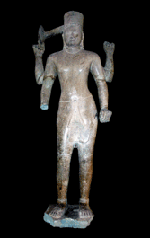 Material:
Sandstone
Material:
Sandstone
Dimensions: H: 193 cm
Date: VIth century
Provenance: Tuol Dai Buon, Prey Veng province
Collection: National Museum of Cambodia,
Phnom Penh
B.343 B.30.15 Ka.1597
This image is dated to the ‘Nokor Phnom’ period (Ist-VIIIth
centuries). The ancient name of Cambodia was ‘Nokor Phnom’
which means ‘mountainous country’. The Chinese transformed
the word ‘phnom’ into the appellation ‘Funan’.
The Venerable Lang Khat wrote: “The Kingdom of Nokor Phnom
is situated on the sea. It is a large delta that stretches to
the east of Lin-yi or Champa (land of the Chams, today in Vietnam)
and the Indian Ocean and the Kingdom of Kin-lin (Gold Frontier)
to the west.”
Various kings reigned over Nokor Phnom and the capital was moved
a number of times. The last capital of this kingdom was situated
at Angkor Borei in today's province of Takeo.
At the beginning of the VIIth century, Nokor Phnom was conquered
by one of its vassal states, the Kingdom of Chenla. Later, this
country was divided into two parts, Chenla of the Earth (to the
north) and Chenla of the Water (to the south).
Funan art is classified as the ‘Phnom Da’ style
(540-600). However, Chenla art is divided into three styles: Sambor
Prei Kuk (600-650), Prei Khmeng (635-700), and Kompong Preah (706-800).
These four styles denote pre-Angkorian art.
According to his attributes, this figure is Visnu (Preserver
of the World). Not only are there representations of Visnu in
Khmer sculpture, but there are many representations of the incarnations
of Visnu such as Krsna, Rama, Kalkin, & etc. On the lintel
no. Ka.1774, Visnu is represented with four arms sleeping on the
naga Ananta in the ocean. Another example in the collection of
the National Museum is the reclining Visnu in bronze, which will
be described below in the metal category. Some representations
in the Museum’s collection represent a combination of Visnu
and Siva known as Harihara.
The presentation of Visnu with four arms depended only on the
sculptor who would like to show the power of the attributes of
Visnu that are considered the perfect weapons to convince enemies.
Alternatively, the four attributes of Visnu represent the four
fundamental elements of the cosmos: fire represented by the disk,
water by the conch shell, earth by the sphere and wind by the
mace.
This divinity leans slightly to the left. The upper right hand
carries a cakra (disk) reinforced by an elongated attachment to
the head, the lower right hand is broken, the upper left hand
holds a conch (broken), and the lower left hand holds a mace considered
to be a prop. The mitre is cylindrical. The forehead presents
a row of curls shaped like silkworms with a fringe below. The
hair falls over the nape of the neck.
This statue demonstrates a traditional way of wearing the sampot
that is often found in ancient Khmer art. This method is called
‘chang kbin’ or ‘can kbin’. The sampot
is made from a rectangular cut of fabric called the dhoti designed
to cover the lower part of the body from the hips. To secure it,
the sampot is knotted over the stomach and the remaining fabric
is passed between the legs. The rolled-up edge is fastened at
the back in the form known as ‘kantuoy kbin’ and is
shaped like a fishtail. The front part of the sampot has a folded
edge above the knee and a fishtail below the stomach. The upper
part of the sampot (around the hips) forms a simple rim. The face
has a faint smile on the lips. The abdomen is distended, the shoulders
are wide and the small bangs on the forehead indicate youth, elegance
and benevolence.


 Material:
Sandstone
Material:
Sandstone